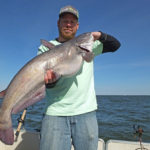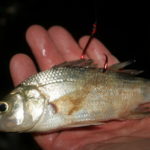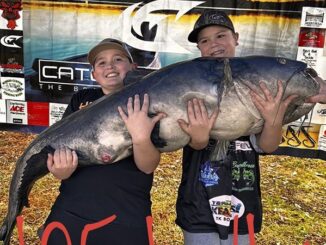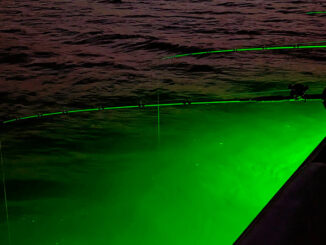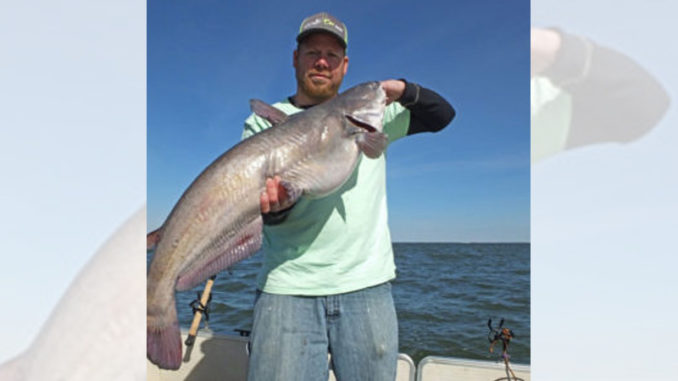
All three species are in play on Lakes, in Canal
Catfish are typically on a strong bite year-round at Santee Cooper, but June offers opportunities to be highly productive in a number of different ways. With the warming water, it’s an excellent time to pursue all of the “big three”catfish species: blue, flathead and channel.
The key for June fishing is versatility in how, when and where you choose to catfish. Jimmy Ledbetter, a veteran fisherman, said the variety of fishing patterns enhances the opportunity to load up on catfish.
“I love the warm-weather months from June right on through the summer for catfish,” Ledbetter said. “Lake Marion and Lake Moultrie are loaded with catfish, and the warm water presents opportunities to fish effectively day or night. Plus, depending on where and how you fish, the bite can be great in shallow or deep water. Finding catfish in June is the same as any time of the year: locate forage, and you’ll find catfish.”
Ledbetter said that gizzard and threadfin shad, white perch and bream are among the favored forage opportunities. But other forage considerations are important, including mussel beds for big blues and other aquatic species targeted by catfish.
“During June, we have a distinct opportunity to catch both big blues and flatheads,” he said. “One of my favorite methods is to anchor fish at night in the shallows around the Diversion Canal or in the Diversion Canal over bottom contour changes. I’ll begin with a variety of baits, and (I) tend to use live baits a lot at night. Large white perch hooked through the back will live a long time and are great for big flatheads and blues. Flatheads love live bait, and blues will readily take it, too. But I always use cut bait as well.”
Ledbetter said if fishermen want fast action, they can downsize baits and rigs and catch plenty of chunky channel catfish in the Canal. Most anglers opt to anchor at night when fishing the Canal and adjacent flats, but they will drift-fish by day using down rigs just ticking the bottom, letting the current move the boat along.
“Current flow in the Canal is a must, but that’s usually not an issue at this time of year,” he said. “But the Canal is just one place that’s productive; both lakes are loaded with catfish.”
Day-night tactics
Ledbetter and his wife, Layla, partner in a lot of catfish tournaments, and they often drift-fish by day. Layla Ledbetter said they watch the depth finder for signs of forage as well as big fish marks indicating possible super-sized catfish before setting up to drift.
“We’ll usually drift-fish deeper water by day, but we’ll graph areas until we see what we want in terms of forage and big fish,” she said. “Drift-fishing enables us to cover more water, which is good for finding fish (that) seem to be more scattered by day than at night. When we find a productive spot, we’ll work it repeatedly until the action slows. Then we’re looking for something similar elsewhere.”
Jimmy Ledbetter said the decision to fish at night usually means fishing shallower water from an anchored position.
“At night, we’ll fish shallow coves, humps, ledges and other bottom topographical features where fish can move quickly from deep to skinny water,” he said. “I anchor most of the time at night, because a lot of forage migrates to the shallows and the catfish follow. I think catfish can ambush the forage better in shallow water at night, so I’ll anchor near deep water and set out multiple rigs. I’ll use an assortment of live and cut baits, and sometimes, we’ll catch both blues and flatheads, while other times one or the other will dominate the catch. Experiment with different baits until you find the right one for the area being fished.”
Ledbetter said the nocturnal bite is often more aggressive than daytime, because fish are often actively feeding and are often congregated in a small, but prime, feeding areas. This seems to create competition that triggers an aggressive bite.
“Stealth is often a key to success at night if you’re searching for big catfish,” he said.
Drift-fishing at night is another June option, one preferred by former guide Marlin Ormseth of Bonneau.
“I prefer to drift-fish at night and have found it’s highly effective during the warm-weather months,” Ormseth said. “I’ll target shallow and deep water, working underwater hills, humps and ledges, drifting the shallows down into deep water and then back up to shallower water. Typically, a pattern develops within a couple hours after dark in terms of fish being caught on specific targets, then I’ll focus on those places. I’ll occasionally run a planer board in very shallow water at night — but well away from the boat. Some big catfish are often caught in very shallow water at this time of year.”
The options for excellent June catfishing are extensive. Day or night, deep or shallow, live or cut bait, all are reasonable options. Pick one that best suits your style of fishing and go catfishing now.

